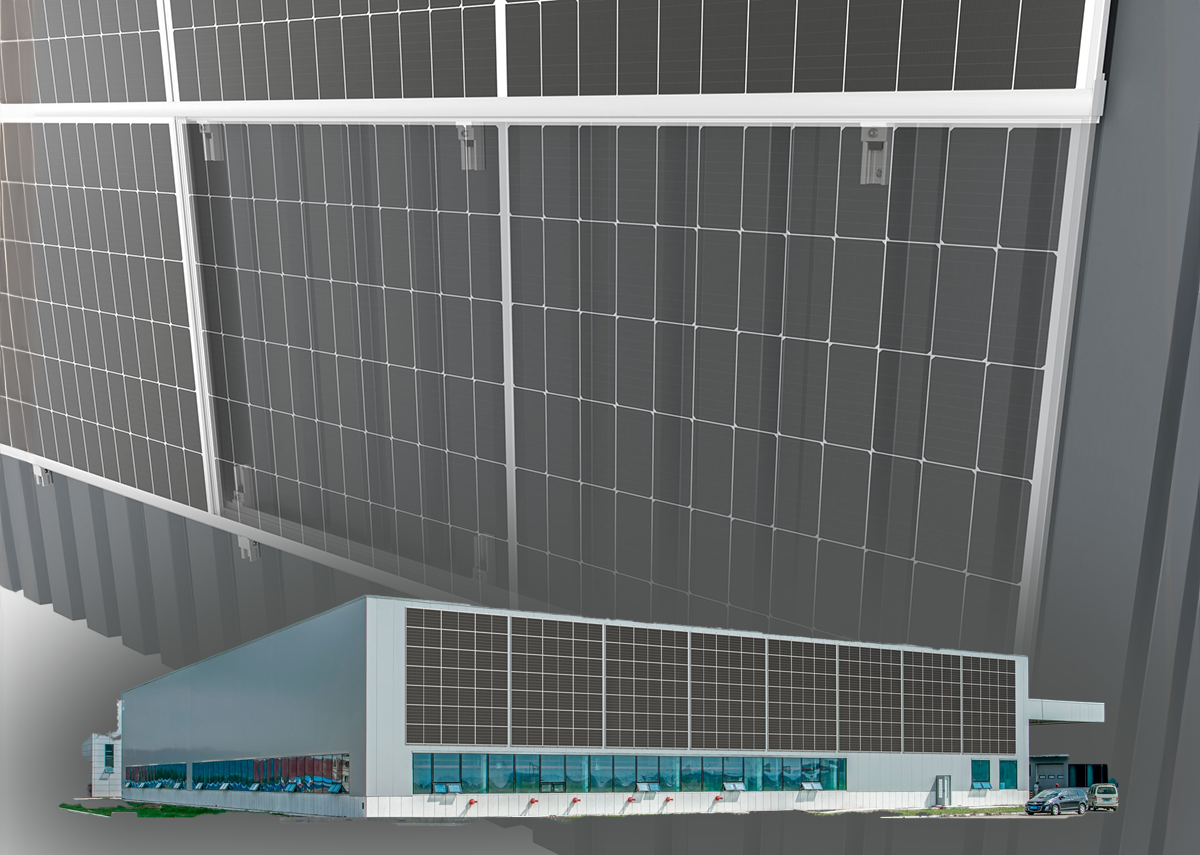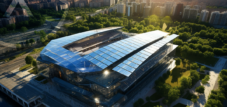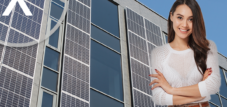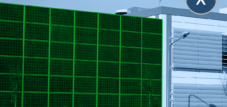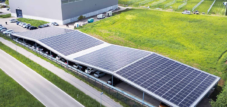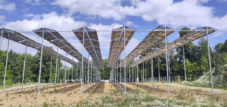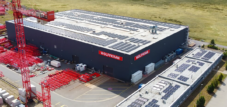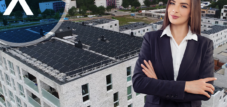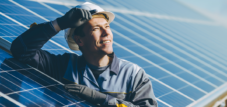Facade solar: Vertical photovoltaic/PV system for building facades – solar power even in winter with a solar facade system
Language selection 📢
Published on: April 30, 2024 / update from: May 2, 2024 - Author: Konrad Wolfenstein
🌞 Vertical photovoltaic systems: An innovative solution for sustainable energy production in winter
🔍 In recent years, research and development in the field of renewable energies has intensified, with a particular focus on the optimization and efficient use of existing technologies. One of the prominent examples of these efforts is vertical photovoltaic systems, which represent a promising alternative to traditional roof-mounted systems. The benefits and impacts of these systems, particularly with regard to energy production in winter, mark a significant advance in the field of solar technology.
🌃 The importance of vertical installations
The basic concept of vertical photovoltaic systems is based on their installation on facades or other vertical structures, which distinguishes them from conventional roof-mounted systems. This approach pursues several goals: the efficient use of urban spaces, increasing aesthetic integration into the cityscape and increasing the energy efficiency of buildings. These systems can show their strengths particularly in winter.
🌞 Optimization of energy yields in winter
One of the main attractions of vertical PV systems is the ability to optimize energy yields when the sun's elevation is lower - a condition that often occurs in the winter months. In contrast to roof systems, which are largely designed to be optimally aligned with the sun in summer, vertical systems can benefit from winter solar radiation because the sun shines at a more favorable angle. This aspect makes them a valuable asset for a constant and reliable energy supply throughout the year.
🔄 Lower fluctuation in energy yields
According to studies by the Fraunhofer Institute, vertical photovoltaic systems are characterized by a lower fluctuation in energy yield between seasons. Where traditional solar systems experience a significant drop in output in winter, vertical systems can deliver a more balanced energy contribution due to the smaller differences in solar radiation between summer and winter. This stability greatly facilitates the systemic integration of the solar energy generated and helps ensure a more reliable energy supply.
🔧 Advantages compared to environmental influences
Another crucial advantage of vertical PV systems is their lower susceptibility to environmental influences. While in conventional systems snow, leaves or rainwater can have a negative impact on energy production by covering the modules, vertical systems are largely unaffected by this problem. The vertical orientation allows such materials to slide naturally, thereby not compromising energy production efficiency. In addition, vertical mounting leads to lower operating temperatures of the modules, which has a positive impact on the performance and longevity of the system.
🏙️ Challenges and future prospects
Despite these obvious advantages, vertical photovoltaic systems also face challenges. Integration into urban environments requires careful planning to ensure that the facilities do not disrupt the cityscape or impact the quality of life of residents. Additionally, the potential for reflections that could be perceived as glare must be minimized. In addition, the initial investment in vertical PV systems is often higher than with traditional systems, a fact that could deter potential investors.
Despite these challenges, the long-term potential of vertical photovoltaic systems is impressive. They not only enable more environmentally friendly and efficient energy production, but also contribute to the aesthetic enhancement of urban spaces. As technology advances and costs fall, these systems could play an important role in future energy supplies, particularly in densely populated urban areas.
🌱 Generate energy efficiently in the winter months
The promises of vertical photovoltaics are comprehensive: they offer the opportunity to efficiently generate energy even in the winter months, reduce dependence on fossil fuels, help reduce CO2 emissions and support the goal of a sustainable, environmentally friendly future. They represent an innovative approach to solar technology that could fundamentally change the way we think about energy production, consumption and efficiency. However, implementing this technology requires a departure from traditional methods and thinking, a challenge that must be overcome given the global climate crisis and the urgent need to promote renewable energy sources. Vertical photovoltaic systems therefore not only represent a technical innovation, but also a cultural and social change towards a more sustainable and resource-saving approach to our planet.
📣 Similar topics
- 🌅 New Horizons: The Rise of Vertical Photovoltaic Systems
- 🏙️ Green facades: How vertical PV systems could change cities
- ❄️ Winter miracle: The strength of vertical solar systems in the cold season
- 📊 Stable energy: Reduced fluctuation in yields from vertical photovoltaics
- 🍃 Unfazed by the elements: The resilience of vertical solar panels
- 🌍 A step towards sustainability: The influence of vertical PV systems on the CO2 balance
- 💡 Bright spots: Optimization of energy production through vertical PV systems in winter
- 🔄 The renewable energy revolution: How vertical photovoltaics is changing the rules of the game
- 🌱 Sustainable cityscapes: The aesthetic and energetic integration of vertical PV systems
- 💼 Investing in the future: The economic challenges and opportunities of vertical photovoltaic systems
#️⃣ Hashtags: #VerticalPhotovoltaics #RenewableEnergy #SustainableCities #WinterEnergy #EnergyEfficiency
📌 Other suitable topics
🎯🎯🎯 Benefit from Xpert.Digital's extensive, fivefold expertise in a comprehensive service package | R&D, XR, PR & SEM

AI & XR 3D Rendering Machine: Fivefold expertise from Xpert.Digital in a comprehensive service package, R&D XR, PR & SEM - Image: Xpert.Digital
Xpert.Digital has in-depth knowledge of various industries. This allows us to develop tailor-made strategies that are tailored precisely to the requirements and challenges of your specific market segment. By continually analyzing market trends and following industry developments, we can act with foresight and offer innovative solutions. Through the combination of experience and knowledge, we generate added value and give our customers a decisive competitive advantage.
More about it here:
🌞🏢 The future of energy production: Photovoltaic facades will permanently change the construction industry
🔝 Why vertical solar installations are important
The use of photovoltaic systems is growing constantly and rapidly - not just horizontally or diagonally, but also vertically. K2 Systems, a pioneer in the development of advanced assembly systems, is leading us into a future in which the areas for energy production will be expanded to include another crucial dimension: the vertical.
🆕 New horizons in solar technology
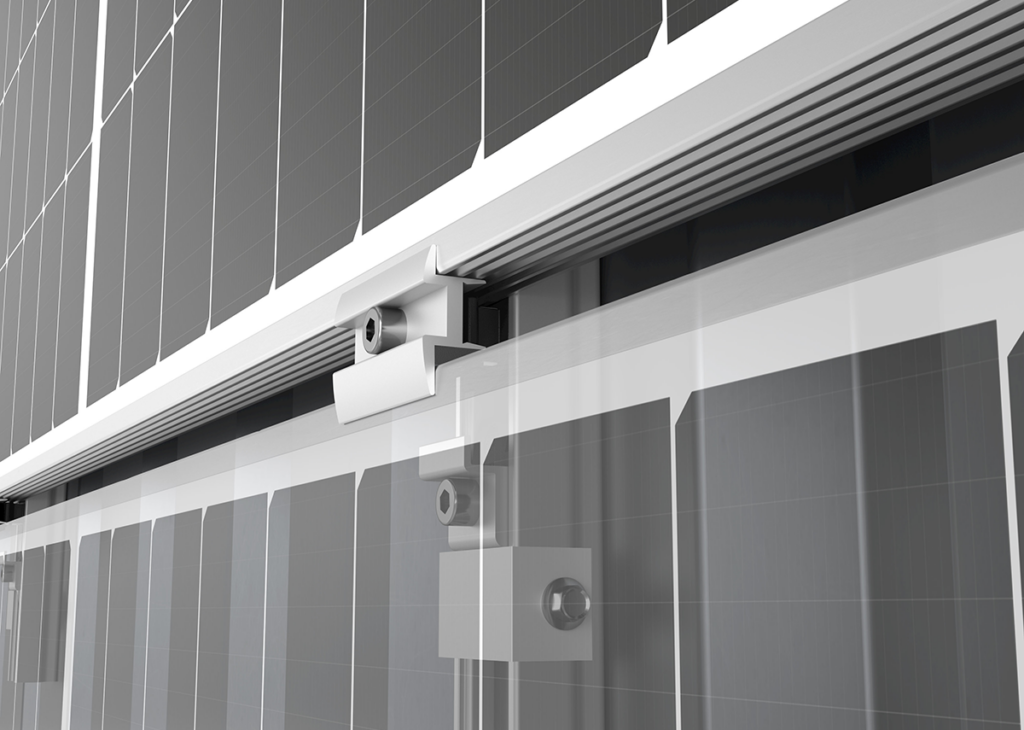
The use of photovoltaic systems is growing constantly and rapidly - not only horizontally or diagonally, but also vertically - Image: K2 Systems
When it comes to conventional installation of solar systems, the first thing that comes to mind is roof surfaces. However, K2 Systems opens up new horizons with its innovative assembly solutions. The systematic and efficient installation of photovoltaic panels on facades marks the beginning of a new era in the use of such systems. This technology is designed to fit a variety of surfaces - from trapezoidal sheet metal and sandwich panels to traditional masonry and concrete. The special feature of these systems is their flexibility; The modules can be clamped, framed and hung, giving planners and installers unprecedented freedom in design. This flexibility is complemented by efficient rear ventilation and an aesthetically pleasing design, which promotes the integration of solar technology into the urban and rural landscape.
📈 Recognize the unused potential
The true potential of photovoltaic facades is considerable, especially given the urgent goal of achieving climate neutrality in existing buildings. In view of a situation in which less than 10 percent of the roof potential and less than 0.1 percent of the facade potential are used in Germany, an enormous, largely unused reservoir for solar power production is revealed. According to studies by the Leibniz Institute for Ecological Spatial Development (IOER) and the Fraunhofer Institute for Solar Energy Systems ISE, the potential for photovoltaics on facades could even be twice that on roofs.
🌍 The role of large buildings
These findings highlight the need to rethink our approach to urban and architectural planning. Large buildings such as production halls, educational institutions and public buildings, but also residential complexes and high-rise buildings, offer a huge area that could be used to generate energy using sunlight. Such facades not only provide unused space for generating solar power, but also represent an opportunity to improve the building's energy efficiency and significantly reduce its carbon footprint.
🗝️ Key to realizing potential
But how can this potential be realized? A key lies in the further development of the technology and the optimization of the assembly systems, as K2 Systems is promoting. Another central aspect is social and political support for these efforts. Extensive incentive systems, for example in the form of funding or legal frameworks, could help to remove obstacles and accelerate the adoption of PV facade technologies.
🎨 Design as a decisive factor
Design is also a factor that should not be underestimated. Aesthetic integration into existing and new building structures is crucial to promote acceptance and dissemination. Innovative technologies that enable solar panels to be harmoniously integrated into architecture could permanently change the landscape of urban design. For example, colored or semi-transparent modules could not only turn the facades of buildings into energy generators, but also visually enhance them.
🔄 A rethink is required
Realizing this vision requires a comprehensive rethink - from the individual level to the community to global structures. Education and enlightenment play an important role in this. People need to be informed about the possibilities and benefits of PV facade systems so that widespread acceptance and participation can arise. It is also necessary to create an infrastructure that facilitates the integration of solar power into the existing energy supply system. This includes both technological development in the area of storage solutions and the expansion of intelligent power grids.
🌐 Fusion of architecture and renewable energies
Ultimately, we are just at the beginning of a development: the fusion of architecture and renewable energies that will shape the face of our cities and rural regions. K2 Systems' assembly systems are an example of how innovative technologies can support our transition to a sustainable and climate-neutral society. The use of facades to generate energy is more than just a technical possibility - it is an expression of our desire to live in harmony with our planet. In the vision of such a future, buildings are no longer just consumers of resources, but active participants in an ecological and social balance.
📣 Similar topics
- 🌞 The rise of vertical photovoltaics: A development with an exciting future
- 🏙️ New horizons: How facades can contribute to energy production
- 🔄 From roof to facade: The development of solar system assembly
- 💡 Photovoltaics on facades: aesthetics meets efficiency
- 🌱 The untapped potential of urban facades in solar energy
- 🔋 The role of technology and innovation in promoting photovoltaics
- 🌐 Buildings as active participants in the fight against climate change
- 📚 Education and awareness as the key to acceptance of PV facade systems
- 💰 How funding and laws drive the adoption of solar technologies
- 🎨 Design and solar energy: A harmonious fusion for the future of architecture
#️⃣ Hashtags: #PhotovoltaicInnovation #FacadeEnergy #SolarTechnologyFuture #SustainableBuilding #ClimateneutralSociety
Plan your solar system for the most common applications conveniently online with our solar system planner!
With our user-friendly solar system planner you can plan your individual solar system online. Whether you need a solar system for your home, your business or for agricultural purposes, our planner offers you the opportunity to take your specific requirements into account and develop a tailor-made solution.
The planning process is simple and intuitive. You simply enter relevant information. Our planner takes this information into account and creates a tailor-made solar system that meets your needs. You can try out different options and configurations to find the optimal solar system for your application.
Additionally, you can save your plan to review later or share with others. Our customer service team is also available to answer your questions and provide support to ensure your solar system is optimally planned.
Use our solar system planner to plan your individual solar system for the most common applications and advance the transition to clean energy. Start now and take an important step towards sustainability and energy independence!

The solar system planner for the most common applications: Plan the solar system online here - Image: Xpert.Digital
More about it here:
We are there for you - advice - planning - implementation - project management
☑️ Smart City & Factory: Industry expert for energetic 5G buildings and halls as well as advice and installation of solar systems
☑️ Xpert.Plus - logistics consulting and logistics optimization
☑️ Industry expert, here with his own Xpert.Digital Industry Hub with over 2,500 specialist articles
I would be happy to serve as your personal advisor.
You can contact me by filling out the contact form below or simply call me on +49 89 89 674 804 (Munich) .
I'm looking forward to our joint project.
Xpert.Digital - Konrad Wolfenstein
Xpert.Digital is a hub for industry with a focus on digitalization, mechanical engineering, logistics/intralogistics and photovoltaics.
With our 360° business development solution, we support well-known companies from new business to after sales.
Market intelligence, smarketing, marketing automation, content development, PR, mail campaigns, personalized social media and lead nurturing are part of our digital tools.
You can find out more at: www.xpert.digital - www.xpert.solar - www.xpert.plus



